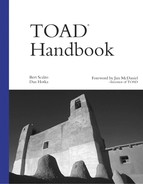Creating the All-Important TOAD Schema
Strictly speaking, you do not have to create any database server-side objects in order to use TOAD. You can simply install TOAD on your PC and go on your merry way. But there are screens where a developer will require access to an Oracle explain plan table. For example, the SQL Editor window has a tab for displaying the explain plan for the current SQL statement. Thus TOAD will need access to a plan table in order to process and then display the resulting explain plan. You have three options here.
First, sometimes DBAs prefer to create a DBA schema-owned, general-purpose and shared explain plan table using Oracle’s scripts. So the steps to implement might look something like this:
-
Connect as SYSTEM (or other DBA account).
-
Run Oracle’s RDBMS/ADMIN/UTLXPLAN.SQL.
-
GRANT ALL ON SYSTEM.PLAN_TABLE TO PUBLIC
-
CREATE PUBLIC SYNONYM PLAN_TABLE FOR SYSTEM.PLAN_TABLE
TOAD can work with such a setup. You should merely set the TOAD options for the Explain Plan Table Name field under the Oracle category to PLAN_TABLE (meaning the public synonym for the general-purpose table set up by the DBA). The TOAD Options screen is launched from the main menu at View, Options and is shown in Figure 1.2.
Figure 1.2. TOAD Options: Oracle explain plans.

There are two caveats with this method. First, you must make sure the DBA schema-owned explain plan table is current for the Oracle version being used. It’s really quite easy to forget to update this table with major Oracle upgrades. This can cause TOAD to encounter problems with missing columns (that is, a call to Oracle will try to populate newer columns that don’t exist in the old plan table structure). And second, TOAD will not be able to save and recall plans if you use this method because TOAD requires its own plan table to support such operations. You must instead use one of the two remaining methods.
Second (and recommended), you can also create a special TOAD schema to own a general-purpose and shared explain plan table using TOAD’s TOADPREP.SQL script (found in the TEMPS subdirectory of the TOAD install directory). TOADPREP.SQL first creates the TOAD schema, and then creates its required explain plan objects. To accomplish this implementation, the steps are as follows:
1. |
Edit TOAD’s TEMPS/TOADPREP.SQL. |
2. |
Connect as SYSTEM (or other DBA account). |
3. |
Run TOAD’s TEMPS/TOADPREP.SQL. |
TOAD will now be able to support the save and recall of explain plans, as long as you remember to check Save Previous Explain Plan Results in the TOAD Options screen under the Oracle category, as shown in Figure 1.2.
The TOADPREP.SQL script has changed significantly with version 7.4. Although the script has always created both the TOAD schema and all its explain-plan required objects, it has been updated such that you only need to modify the first three DEFINE statements in the script in order to control the script’s behavior. It used to be that you had to review the entire SQL script for possible changes. So the new TOADPREP.SQL script shown in Listing 1.1 is much easer to work with.
Listing 1.1. TOADPREP.SQL Script
Third and finally, you can also create a private TOAD explain plan table and all its required objects per TOAD user via the NOTOAD.SQL script (also found in the TEMPS subdirectory of the TOAD install directory). To accomplish this implementation, the steps are as follows:
1. |
Connect as each and every TOAD user. |
2. |
Run TOAD’s TEMPS/NOTOAD.SQL. |
This method is supported for backward compatibility, but it’s very hard to imagine a case where you would want to choose this implementation option. This method would require every TOAD user to have CREATE TABLE privilege, CREATE SEQUENCE privilege, and some tablespace quota on at least one tablespace. Plus it would result in numerous additional database objects as a whole (that is, two tables, two indexes, and one sequence created per TOAD user). But the option does exist for those who want to use it. The only advantage to this approach is that, like the prior method, it too supports the save and recall of explain plans. Because this method is not recommended, the NOTOAD.SQL script is not shown.
